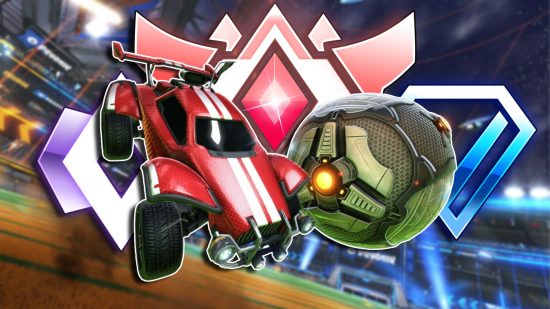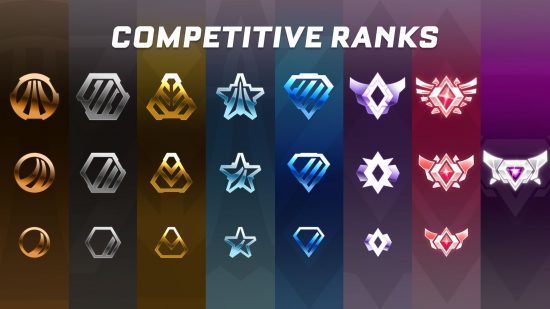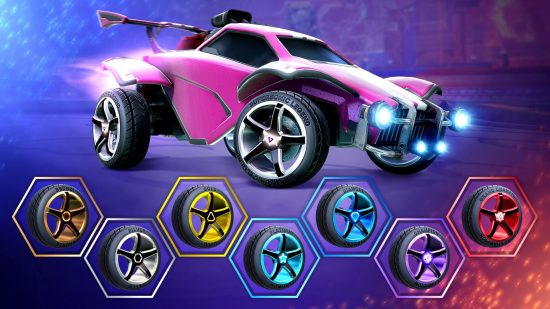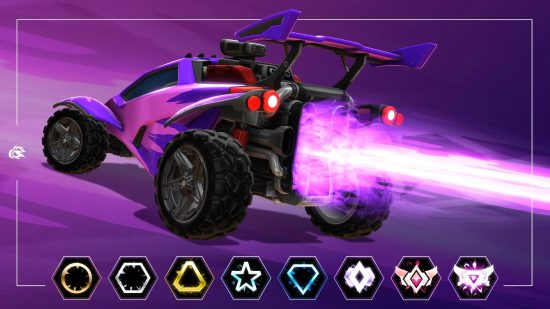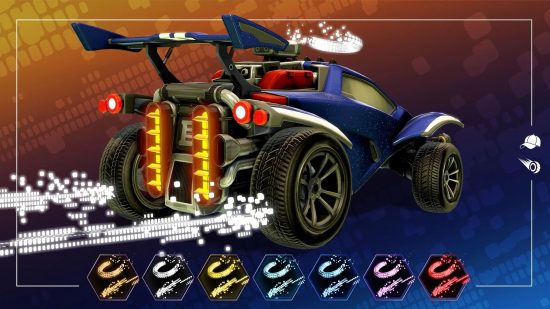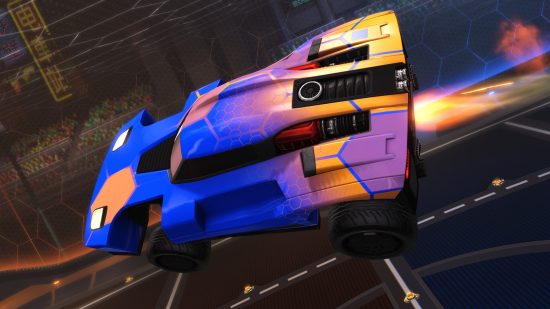What are the Rocket League ranks? We all love a bit of frantic, fast-paced aerial car football, don’t we? Rocket League stands in a field of its own as a competitive multiplayer game, with its mixture of teamwork, coordination, precise aim, and driving skills making it hard to squeeze into any pre-existing genre. But how does the ranking system work? Don’t worry, we’ve got you covered with the ins and outs of the Rocket League ranks explained, with all the details on MMR, skill distribution, and more, including a few tips and tricks to improve your Rocket League rank.
Because it’s so unique, Rocket League has a massive following and has become a top-tier esport. But it isn’t just the pro players who get to play competitively; Rocket League has a ranking system that allows you to progress through the ranks from Unranked to Supersonic Legend across a host of different competitive game modes. If you want to improve your skills in one of the best games out there, or you’re just a sucker for the grind, then ranked play is where you’ll want to be.
What are the Rocket League ranks?
There are currently 23 Rocket League ranks from Unranked to Supersonic Legend. The majority of ranks are split into three sub-divisions, which are further broken down into tiers that are used to judge your progress through each rank and division.
The Rocket League ranks are:
| Rank | Symbol |
| Unranked | |
| Bronze I | |
| Bronze II |  |
| Bronze III | |
| Silver I | |
| Silver II | |
| Silver III | |
| Gold I | |
| Gold II | |
| Gold III | |
| Platinum I | |
| Platinum II | |
| Platinum III | |
| Diamond I | |
| Diamond II | |
| Diamond III | |
| Champion I |  |
| Champion II |  |
| Champion III | |
| Grand Champion I | |
| Grand Champion II | |
| Grand Champion III | |
| Supersonic Legend |
If you’re a veteran, then this might look a little different than the last time you played. Before the massive free-to-play update in September 2020, Grand Champion was the highest Rocket League rank that players could reach. However, Grand Champion has been knocked into second place and divided into three sub-tiers, with Supersonic Legend now being the ultimate accolade for competitive players looking to reach the highest Rocket League ranks.
It’s also worth noting that each of the competitive game modes in Rocket League has its own ranking ladder to climb, so you will have a different rank in each mode. For example, you could be a Platinum 3 player in Standard, but only Silver 2 in Doubles. This is important as you’ll be paired with players of a similar skill level in each mode.
What is Rocket League MMR?
Rocket League MMR stands for Matchmaking Rank and is a hidden score that determines what rank you are in and acts as a way to place you against opponents with roughly similar skill levels for balance. Wins make it go up, losses make it go down, and each rank and division has a set MMR target value you need to reach in order to progress.
Your rank (e.g. Gold 1) is just a visual representation of your Rocket League MMR value and players in the same rank as you are of roughly the same skill level. As you get better or worse, so should your rank.
The amount of MMR you earn for each win or lose for each defeat is determined by the MMR of your opponent. For example, if you face an opponent who has a higher MMR than you, you will gain more MMR points for a victory than you would have beating someone of the same MMR.
Goals, assists, and MVP awards don’t affect the amount of MMR you gain, despite contrary beliefs.
If you’re queueing up as a party in Rocket League ranked play, MMR is calculated slightly differently when it comes to matchmaking. Each player in the party will have their MMR value tweaked for those matches, and this is weighted more heavily towards the best and highest-ranked player in your party. This is to prevent a single high-ranked player from being able to join lower-ranked friends to face off against easier opposition, and effectively carry a team to victory. Instead, you’ll be matched into higher MMR matches, so be careful if you’re relying on a single player who’s more skilled than you.

Rocket League ranked rewards Season 12
The Rocket League ranked rewards for Season 12 are currently unknown, though we’ve yet to receive an antenna or paint finish, so these are likely candidates. However, many fans are also hoping for a goal explosion item.
For reference, the Rocket League ranked rewards for Season 11 was a set of limited rocket boosts based on the color of each rank division. Each has a unique sound effect to match. These aren’t the most flashy boosts in the game, even compared to previous Seasonal boosts (such as Season 2), though these are still great rewards for those looking to show off their rank in style.
The Rocket League ranked rewards are Seasonal and include cosmetic items like rank-specific titles, banners, rocket boosts, decals, wheels, and more. You will be rewarded based on the highest Rocket League ranks you’ve achieved in the current Season, though the rewards will be given at the start of the next Season.
These are a great way to show off your achievements in the competitive ranking system to other players. Given these are Seasonal, however, they are only available for a limited time, with the reward changing each Season.
How to unlock Rocket League ranked mode
To unlock Rocket League’s ranked mode and playlists, you must reach level ten in the game by playing regular modes. This is to ensure players have a decent knowledge of Rocket League before diving into competitive matches, while also making ‘smurfing’ slightly less prevalent, as players will need to put in more work before they can enter the competitive modes.
Once the ranked mode is unlocked, you will then play some placement matches to determine which rank you should start at. This is the reasoning behind the Unranked rank, as this is where new players will begin before completing all their placement matches.
How do Rocket League ranks work?
Once you’ve played your placement matches and assigned your starting rank based on those results, you will then start to be matched with players of roughly the same skill level as you. The tiered ranking system in Rocket League works using your MMR value. Wins will see you move up the ranking system and losses will see you fall.
Each rank has a specific MMR threshold, so once your MMR value exceeds the maximum value of that threshold, you are promoted to the division above. The actual values of the thresholds are subject to change and can shift depending on how many players are in certain ranks in order to keep things balanced and not have too many players up in the higher rankings.
Rocket League rank distribution
At the end of each season, Rocket League players are always interested in seeing the rank distribution. With so many Rocket League ranks to climb in competitive, they often wonder ‘how many players actually reached the very top tier?’ and ‘what is the average rank in Rocket League?’. With the latest rank distribution data, you’ll be able to see the spread of the player base, giving you a good benchmark to see how well you did that season.
The Rocket League rank distribution at the moment (updated November 2023) shows how things are looking across the three core competitive ranked modes. The percentage shows how much of the overall player is sitting in each rank, in each of the core competitive modes.
| Tier | Duel | Standard | Doubles |
|---|---|---|---|
| Unranked | N/A | N/A | N/A |
| Bronze 1 | 0.04% | 0.07% | 0.04% |
| Bronze 2 | 0.1% | 0.15% | 0.07% |
| Bronze 3 | 0.28% | 0.40% | 0.17% |
| Silver 1 | 0.70% | 0.99% | 0.38% |
| Silver 2 | 1.60% | 2.13% | 0.78% |
| Silver 3 | 3.28% | 3.93% | 1.47% |
| Gold 1 | 6.37% | 6.47% | 2.63% |
| Gold 2 | 10.41% | 8.73% | 4.07% |
| Gold 3 | 14.37% | 10.31% | 6.01% |
| Platinum 1 | 17.63% | 11.22% | 8.66% |
| Platinum 2 | 16.09% | 10.69% | 10.38% |
| Platinum 3 | 11.81% | 9.74% | 11.10% |
| Diamond 1 | 7.80% | 11.06% | 14.63% |
| Diamond 2 | 4.44% | 8.23% | 12.37% |
| Diamond 3 | 2.38% | 5.82% | 9.53% |
| Champion 1 | 1.32% | 5.31% | 9.38% |
| Champion 2 | 0.66% | 2.50% | 4.57% |
| Champion 3 | 0.34% | 1.25% | 2.24% |
| Grand Champion 1 | 0.19% | 0.67% | 1.11% |
| Grand Champion 2 | 0.09% | 0.25% | 0.29% |
| Grand Champion 3 | 0.05% | 0.07% | 0.08% |
| Supersonic Legend | 0.06% | 0.01% | 0.03% |
With only less than 2% of ranked players ever reaching Grand Champion rank or higher in any of the main game modes, you can see just how difficult it is to be the very best at competitive Rocket League. The majority of players are placed, as you might expect, in the middle of the Rocket League ranks brackets in Gold and Platinum especially.
Rocket League ranks playlists
- Standard (3v3)
- Doubles (2v2)
- Duel (1v1)
- Hoops (2v2)
- Snow Day (3v3)
- Rumble (3v3)
- Dropshot (3v3)
There are seven ranked playlists to choose from in Rocket League. The main three (Standard, Doubles, and Duel) are the most popular and serious playlists for competitive players.
The four other modes still give you a rank and rewards to aim for, but while playing more experimental and fun modes in a slightly less competitive environment.
This means there’s a good mix of modes for those perhaps looking to give the Rocket League ranks system a try, but don’t want to go in at the deep end with the most competitive modes. If this is you, then we recommend giving Snow Day and Hoops a try, as these a fun spins on the traditional Rocket League gameplay, while also giving you a rank to aim for, with more of a drive to win.
How to improve your Rocket League rank
Here are a handful of tips and tricks to improve your Rocket League rank:
- Learn how to hit the ball without giving away possession – the last thing you want to do is give the ball to your opponent when you’re trying to maneuver with the ball. Practice controlled touches and accurate aerial hits.
- Play defense – an easy way to lose a match is focusing too much on scoring, and not enough on stopping the enemy. To get better at defending keep an eye on your teammates and your overall positioning so you can better react to opponent plays.
- Positioning – strong positioning is vital to offense, not just a strong defense. Take note of your allies’ positions and where your opponents are coming from to look for openings. Remember, you can pass to allies and clear the ball, so when everyone’s in a good position, this a great options.
- Practice mechanic skills – techniques like accurate and fast aerial shots (‘aerials’) and rotations are vital in keeping up with your opponents when defending or pressing the attack.
- Watch pro players – learning from the best players in ranked will go a long way in teaching you new tricks you might have missed.
These are the general fundaments of competitive play in Rocket League ranked, though it’s easy to overlook these, especially in lower tiers where your opponents will often charge right for the ball no matter what. However, having a clear game plan and great mechanical skills will put you a cut above the competition so you can hopefully rise up the ranks.
Rocket League rank tracker
If you’re looking to find out exactly where you rank in the avid community, you should use a Rocket League rank tracker such as Rocket League Tracker Network. Here you can enter your account name to check your stats and compare them to others in the leaderboards.
In fact, this Rocket League rank tracker also has an in-game overlay which many players use to keep track of their performance in a game, including lifetime stats and even a live match roster. This is great for getting an insight into your opponents (or teammates) before a match.

Should you play Rocket League ranked?
Yes, if you’re up for the added challenge of Rocket League’s ranked competitive modes, then it’s certainly worthwhile. By adding more weight to each win and loss, every pass and shot on goal matters. For those who find competitive experiences more enjoyable, this is crucial as it gives you a target to achieve.
Moreover, there are also exclusive rewards up for grabs depending on which rank you end up in. While not all rewards are equally worthwhile, they are exclusive nonetheless.
However, if you really don’t enjoy competitive games and would rather just have fun in the low-stakes modes, then that works too. You don’t have to play ranked if you don’t enjoy it.
That’s everything you need to know about the Rocket League ranks and the latest Rocket League ranked season. Make sure you check out our other guides, from the best Rocket League cars to Rocket League clears to hone your skills. If you’re looking for a new challenge, you can always consult our best multiplayer games list for your next competitive adventure.
If you’re looking to find that extra competitive edge, then be sure to check out the best PS5 controllers, best Switch controllers, and best Xbox controllers you can get your hands on. See you on the pitch.
